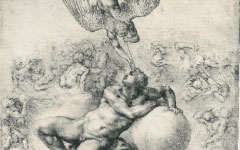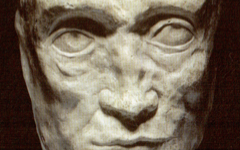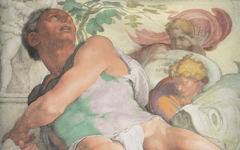Michelangelo’s Archers Shooting at a Herm (c.1530) Part 1
In the Renaissance sculptors used a tool, called a bow - or arco in Italian - to drill holes in marble. The modern Italian term for it, still linked to archery, is archetto (see photo). Michelangelo used the word to compare himself to his sculpture, David, on a drawing of David. He wrote next to the image: ‘David with his sling / And I with my bow / Michelangelo.’ Thus scholars, not wedded to the concept that David is a political allegory, have long recognized that his giant masterpiece is really a representation of the great sculptor himself with a sling in place of his sculptor’s bow.1
Click next thumbnail to continue

Michelangelo, Archers Shooting at a Herm (c.1530) Red chalk. Royal Collection, Windsor Castle
Click image to enlarge.
What they have not recognized, though, is that the same method is at work in a celebrated drawing, Archers Shooting at a Herm. The archers who mostly have no actual bows in their hands.....
Click next thumbnail to continue
....resemble a sculptor at work, with one hand in front holding a chisel and the other behind with a hammer. Inexplicably, at least on the surface level, the archers aim at a stone sculpture, the herm at right. Inside Michelangelo’s mind, though, the nude, muscular archers metaphorically represent the force of a sculptor and the violence of artistic creation. There is logic to the missing bows and the stone target. The arrows are spiritual chisels and the herm, representing a sculpture in progress, is made of stone.2
Click next thumbnail to continue

Left: Detail of Michelangelo's Archers Shooting at a Herm
Right: Diagram of a Renaissance sculptor's bow
Click image to enlarge.
Even the one archer holding a bow, the only one bearded like Michelangelo too, is holding it in the same direction as he would have held the drilling tool named after it. That is another reason why the other archers do not hold bows: they would be aiming them (as drilling tools) at themselves! Moreover, all but one archer is left-handed suggesting that they are reflections of the artist, as seen in the mirror of his mind.
Click next thumbnail to continue
The motivating idea is the same underlying theme as I have shown in Michelangelo's earliest extant sculpture The Battle of the Lapiths; only the surface story, the outer form, has changed. The face on the herm, being ‘sculpted’ by the archers, has even been thought to resemble Michelangelo. Regardless, the herm must represent the artist because all his sculptures do and the erect phallus displays his fertility. There are few certainties in art but this is one: Michelangelo the sculptor sculpts himself.3
For Part 2 of this explanation, click here.
More Works by Michelangelo
Learn how Michelangelo's The Dream of Human Life, traditionally interpreted as an allegory of virtue and vice, is instead a visual metamorphosis of the artist's head.

Michelangelo’s The Dream of Human Life (c.1533)
Notes:
1. Charles Seymour, Michelangelo’s David: A Search for Identity(The University of Pittsburgh Press) 1967, pp.7, 16.
2. Hartt commented that, “[T]he disconcerting absence of bows remains unexplained, particularly when the single figure who has one bends it the wrong way..” The Drawings of Michelangelo (London: Thames & Hudson) 1971, p.253
3. Robert J.Clements, The Poetry of Michelangelo (New York University Press) 1966, p. 113. A decade later Michelangelo included St. Sebastian in the Last Judgment holding the arrows of his martyrdom like paintbrushes. By placing him in the pose of an archer he once again indicated that the painter paints himself: martyr and executioner are one and the same.
Original Publication Date on EPPH: 23 Feb 2012. | Updated: 0. © Simon Abrahams. Articles on this site are the copyright of Simon Abrahams. To use copyrighted material in print or other media for purposes beyond 'fair use', you must obtain permission from the copyright owner. Websites may link to this page without permission (please do) but may not reproduce the material on their own site without crediting Simon Abrahams and EPPH.





